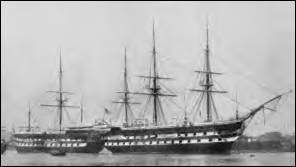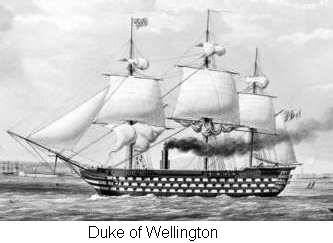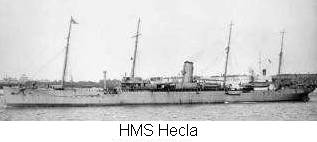Henry Ernest Wright was born in Exeter on 14th February 1878, the fourth of the seven children of William Wright. William had come to Exeter from Teingcombe to work as a cook, where he married Maria Standlake, the daughter of an accountant. Henry joined the Navy as a cooks mate when he was just 18. It is not known how Henry became associated with Winkleigh as his family remained in Exeter (with a short stay in Dartmouth) until after his father died when Henry was age 21. There seems to be no family connexion with Winkleigh, although Henry may have moved his family to Winkleigh sometime after 1911, or his mother may have moved there after all her children married.
When Henry joined the Royal Navy on 20th April 1896, he signed on for 12 years, and was described as 5ft 5in tall with light brown hair, blue eyes and a fair complexion. His occupation was then a baker, and with a father and an older brother who were both cooks, it seems that the Navy offered Henry the additional training to become a professional cook fairly quickly. Henry initially went as an acting 2nd class Cook’s mate for training at HMS Victory I, which was an accounting shore establishment at Portsmouth. After six weeks he was promoted to full 2nd class for three months further training, when he served on board a HMS Lion for a year when he was further promoted to Cook’s mate.
Henry initially went as an acting 2nd class Cook’s mate for training at HMS Victory I, which was an accounting shore establishment at Portsmouth. After six weeks he was promoted to full 2nd class for three months further training, when he served on board a HMS Lion for a year when he was further promoted to Cook’s mate.
HMS Lion (left)
HMS Lion was being used as a training ship based at Devonport to where Henry went for further training at the shore establishment there in October 1897. After six months, Henry was assigned to HMS Revenge for the next thirteen months. The Revenge was a pre-dreadnaught battleship and although the fastest type of battleship in the world at the time, she was destined to become obsolete in 1906 with the introduction of the dreadnoughts. At the time Henry joined her, the Revenge was with the International Squadron blockading Crete and landed Marines there during the Greco-Turkish uprising. In September 1898, the Revenge went to Candia to support the British garrison there. About a year later, Henry’s father died at the age of 49, leaving Henry’s mother with two daughters who were working and with son Bertie age about 6. In December 1899 the Revenge returned Malta to continue Mediterranean Fleet service until the following April when she returned to England, and  Henry was assigned to the battleship HMS Victorious for just a month before another spell of training at Devonport. There followed five of months on HMS Duke of Wellington, once rated as the most powerful warship in the world, and eventually with added steam engines, but now coming to the end of her career. As from March 1901, Henry was once again in Devonport where he is recorded in the 1901 census as boarding at The Catholic Home 29 Marlboro Street along with other sailors.
Henry was assigned to the battleship HMS Victorious for just a month before another spell of training at Devonport. There followed five of months on HMS Duke of Wellington, once rated as the most powerful warship in the world, and eventually with added steam engines, but now coming to the end of her career. As from March 1901, Henry was once again in Devonport where he is recorded in the 1901 census as boarding at The Catholic Home 29 Marlboro Street along with other sailors.
On 9 November 1901, Henry was transferred to HMS Triumph, a broadside ironclad battleship of the Victorian era, but now in the reserve, disarmed and used as a depot ship at Plymouth. During the two years aboard the Triumph, Henry was promoted to 2nd class Cook. It was around this time that Henry married Beatrice Maud Heydon when the Triumph was converted to a training ship, and Henry again returned to Devonport early in February 1903.  From July Henry spent short periods of duty on gunboat HMS Bramble, base ship HMS Tamar in Hong Kong and torpedo boat HMS Hecla. Then periods of service at the shore establishments in Devonport from 1905, including a year at the shore establishment HMS Impregnable there, until February 1907. Then he was assigned to the torpedo boat depot ship HMS Vulcan for a month before being promoted to Ship’s Cook and spending a year on HMS Orion. Orion had been a battleship of the Victorian Royal Navy but was now used as a depot-ship at Malta for torpedo-boats.
From July Henry spent short periods of duty on gunboat HMS Bramble, base ship HMS Tamar in Hong Kong and torpedo boat HMS Hecla. Then periods of service at the shore establishments in Devonport from 1905, including a year at the shore establishment HMS Impregnable there, until February 1907. Then he was assigned to the torpedo boat depot ship HMS Vulcan for a month before being promoted to Ship’s Cook and spending a year on HMS Orion. Orion had been a battleship of the Victorian Royal Navy but was now used as a depot-ship at Malta for torpedo-boats.
Returning from Malta, Henry spent a month at Devonport, where he is reported as having tattoos of a woman on both arms, before being assigned to HMS Theseus (the tender ship for the gunnery training ship HMS Cambridge at Devonport) and HMS Indus (the mechanics’ training establishment and workshops at Devonport) for the most of 1908. After another month at Vivid, Henry was assigned to the newly commissioned armoured cruiser HMS Defence, which was the last armoured cruiser built for the Royal Navy. Henry spent two years on the Defence, during which time he was promoted to Chief Ship’s Cook. Later, HMS Defence was to be sunk at he battle of Jutland, being hit in the magazine and losing all on board. Up to now it seems that Henry had spent most of his time in Devonport. By the time of the 1911 census, he had three children and another two that had died. After another seven months back at Vivid, Henry was assigned to HMS Blake for a further two years. HMS Blake, a protected cruiser, had been completed in 1892, and became the flagship of the North America and West Indies Squadron, later serving in the Channel Fleet. When Henry joined HMS Blake, she had been converted into a destroyer depot ship carrying around 600 tons of fuel in 1-cwt bags for the destroyers.
When Henry left HMS Blake on 21 December 1913, he went on ten days leave over Christmas before returning the Devonport for a couple of months before his next posting to HMS Caesar. The Caesar was completed in January 1898 was the largest battleship ever built at the time, boasting four 46-ton 12-inch guns and twelve 6-inch guns as well as five torpedo tubes and 9 inches of Harvey armour. Although initially coal fired, she had been converted to oil. Henry now had over three years as Chief Ship's Cook and was given the appropriate badge and was to stay on HMS Caesar for most of the war which was soon to start. When Henry first joined the Caesar, she was in reserve but when war broke out she was assigned to the Channel Fleet, and presumably Henry was still able to get home from time to time. However, in December 1914 the Caesar was sent as a guard and gunnery training ship at Gibraltar and in July 1915 she was transferred to the North America and West Indies Station. There, she served as guard ship and gunnery training ship at Bermuda and patrolling the Atlantic. She also spent some time in Halifax during 1916. It is not known why or when Henry moved his family to Winkleigh, but it could have been at this time when he was sent across the Atlantic.
It was not until 28 October 1917 that Henry returned to Vivid at Dartmouth where he stayed for the rest of his naval career. Although he had seen some operational deployment at the beginning of the war, he must have spent a relatively safe and enjoyable time during the war. His conduct had been reported as superlative from very early on, so it is surprising that in September he was found guilty of theft and lost six months seniority. His conduct returned to superlative and in 1919 he was promoted to Petty Officer Cook and finally left the Navy on 23rd June 1921.
8 October 2012


